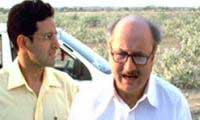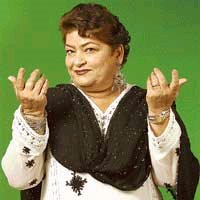
There is something common between Bandra Kurla complex in suburban Mumbai, Rajarhat in Kolkata, the Rave Multiplex in Swaroop Nagar, Kanpur and Vikas Sweets at Center Point in Aligarh. Something that -
1. creates an illusion of space & modernity where none exists..
2. is testimony to the fact that what matters more is what is outside than what is inside..
3. reminds us to refresh our the notions of beauty..
India’s urban landscape is acquiring reflective surfaces like never before. From shopping malls, education institutions, commercial plazas, all the way to satsang bhavans & even mithaai-wallahs. Suddenly our collective consciousness of the contemporary architecture is impressed by nothing less than what is reflective. Be it Glass in its different avatars - Dark glass, Mirrored glass, Coloured glass, Strong glass. Or the new breed Metal finish panels. These panels also come in different colours - starting with shades of gray, bright reds, yellows, blue and many more.
Remember the last time you stepped into a shop selling apparel or mobile phones. The shop would not have been more than double your shoulder spread in width, but it sure must have seemed much bigger than that, just because one of the walls was all Glass!
Or, better still, the swank new look at the neighbourhood mithaai-wallah (sweetmeat shop), who had been operating only from one corner of his shop for the past one month because of this ‘renovation work’ that was underway.
The shop with the mirror wall made you feel space and the new improved reflective façade at your regular mithaai wallah makes you feel good about buying sweets. Today it is as much ‘refined’ a place as the refined cooking material that it uses. The mithaaiwallahs are beginning to get more careful about their image in times of the doughnut, and the sizzling chocolate brownie, onslaught!
These reflective surfaces are accomplishing that which even the best of town planning has failed to.
The super-cooled liquid along-with the, matte-effect, metal finish surfaces are creating illusions of extra space which do not exist. They create perceptions of sanitized cleanliness, limited to the confines of the structure that one is in. They help us forget the failure of infrastructure elsewhere in the city. These reflective surfaces are the new age signifiers of modernity that is driven by the newness of the structures that bear these surfaces.
Beyond the general feeling of space & modernity, the predominance of glass in urban landscapes, is making people look at themselves much more than what they ever did.
Remember when you saw Mrs. ‘Afternoon Shopping’ (“shop till the maid drops!”) mending her hair in the one-way glass of the mall façade & and the, barely 21, Mr. ‘Relationship Turnover’ (”My girlfriend I have to be on my network & tariff plan, SMS is cheaper that way!”) looking at his Fossil watch in the mirrored interiors of a shopping arcade.
Narcissism in contemporary urban India is gender neutral & reflection nourished! The notion of beauty/look needs to be refreshed constantly. Sometimes even more than what we do while surfing web pages!
As a society we have never loved to look at ourselves more than this or may be we never got to. Remember how standing in front of the mirror, at home, longer than the 2-3 minutes allotted to boys for combing (which was almost all that grooming stood for) was considered not normal!
There is more to these reflective surfaces than this. They also have a bearing on the way we carry ourselves in impersonal zones.
Look at the way people begin to behave as they move into the vicinity/ inside of a structure defined by its brightly lit and beautifully reflective space. Be it a Mall, Multiplex or even a mercantile bank. Observe the way people instantly suspend conversations that require them to talk in a language other than English. They begin discussing other, more English language compliant topics! They talk and inquire about products and services and the medium is the English language.
Even gait turns into a careful and calculated one. As they attempt to display poise to go with the people and products that they see around.
People seem to turn into pawns on a chessboard that uses vitrified tiles for its surface. A surface glistening in the warmth of the spotlight staring from the top and in the chill of the air-conditioned, dust-free virtual weather!
Many a times there is a young boy or girl who accompanys his/her parent while they shop. This is not just to carry the shopping bags. More often than not these ‘young boys and girls act as the bridge between money earned the old economy way – Parents and the money spent on new age products and services – Products and the sanitized retail space.’
One wonders how many times these parents, and many more like them, who are a generation too old to gear up to the new ‘reflective reality’ end up not coming to ‘the modern reflective spaces’ out of the fear of looking unprepared for the products & services being offered there. Out of the fear of not coming across as the perfect consumers for the perfectly laid out these modern spaces.
Research has shown that most of the times they end up feeling under-dressed and under-groomed for these new spaces. Many of them have begun to dress up for a visit to these Malls and Mercantile banks. This is in contrast to the much ‘simpler’ putting on of a bathroom slipper and holding of a, homemade, bag of cloth to buy the monthly grocery or walking in sandals to the nearby bank branch.
On one hand reflective spaces create islands of virtual perfection, right in the middle of grave infrastructure inconsistencies. This in turn aids in suspending disbelief, as people are tempted to buy more.
On the other hand these reflective spaces also run the risk of blocking out a large chunk of prospective consumers.
Interestingly, while the new reflective spaces & structures face the possibility of having blocked out a section of consumers, the traditional shopkeepers are doing well for themselves as they successfully reinvent their retail spaces by deploying the power of reflectology alongside their age-old relationship skills - their personal touch.
Thus when Verma ji goes to buy mithaai (sweets) or the monthly grocery, he feels rewarded because the new Jain Caorner (as it is called now) wears a an imposing reflective look, yet it extends the same old personal service that Verma ji has known for the past over 10 years.
Notions of modernity, created by reflective surfaces, in urban India, are working as much for the marketers as they are against. While the marketers try and render an ever-improving experience to their consumers, they must constantly put their offering to the critical test of consumer’s psychological comfort with the degree of perfection in the retail space. They must know that the new look need not be new at the cost of isolating the larger group of consumers.
Smart marketers are always ahead of their consumer, but only as much ahead that they can see him in their rearview mirror…







































